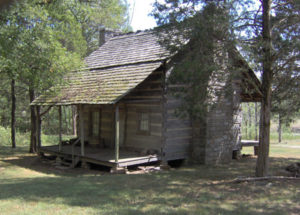
Frontier log cabin much like those built in the Red River region of Northeast Texas until statehood in 1856. (Photo Wikimedia Commons)
Okay, here’s the question I’ve wanted to pose for a long time. Who were the first Anglo-American settlers in Texas? If you said Moses or Stephen Austin, you missed it by a long shot. The first settlers to arrive from the United States came into Northeast Texas by 1815.
Yes, 1815 when Texas was part of Spain. Rex Strickland was probably the first professional historian to examine the area from Arkansas/ Louisiana borders westward to what is Interstate 35 today and from the Red River south to today’s Interstate 20. That’s a pretty big chuck of land that is often overlooked in Texas history.
The date of 1815 is based on tales from three U. S. soldiers participating in the War of 1812 in the Battle of New Orleans. These three nameless men decided to do a little exploring on their way home to Tennessee. And we all know what excellent wilderness prowess Tennesseans like Davy Crockett had.
The men crossed the Sabine River and headed north. There are indications they followed that river to its headwaters in what is now Hunt County. Along the way there were mesmerized with the woods, the tall grass prairies, the abundance of water, and wide variety of game. Black bear, buffalo, pronghorn antelope, deer, mountain lions, butterflies, grassland birds and other wildlife were everywhere.
However, as they neared the Red River they met other hunters and trappers along the way. Colonel William Mabbitt in partnership with brothers Alex and George Wetmore operated a trading post. After a short spell the men from Tennessee made their way home to share stories of the wonderful sights they had seen.
Not long afterward, more settlers led by Claiborne Wright moved into the region. Gradually the area filled with new families. By 1821 Spain lost its control over the area that became part of the new republic Mexico. The politics had little to concern residents who believed they lived in Miller County, Arkansas Territory of the United States.
Moses Austin, on his way to Mexico City in 1820 to plea for a colonial grant from the Spanish government, stopped to visit his old friends the Wrights. Later when his son Stephen F. Austin gained the grant from Mexico, some of the Red River settlers followed him to the new Austin Colony near the mouth of the Brazos River on the Gulf of Mexico. Many remained along the Red River, though.
The distance, the remoteness, and the sparse population kept knowledge of the Red River region secret for a long time. Most of the Red River settlers were either unable to write or had little or no time to record their stories. Life was hard.
Red River settlers followed the Texas legend that men came to Texas fleeing from the law, one step ahead of the debt collectors, or escaping a bad marriage. While many of the newcomers fell into at least one of those groups, some men brought families to created orderly settlements. Descendants of those men still reside along the Red River and its tributaries.
